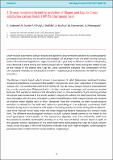Por favor, use este identificador para citar o enlazar a este item:
http://hdl.handle.net/10261/270858COMPARTIR / EXPORTAR:
 SHARE
BASE SHARE
BASE
|
|
| Visualizar otros formatos: MARC | Dublin Core | RDF | ORE | MODS | METS | DIDL | DATACITE | |

| Título: | A 16-year morphobathymetric evolution of Blanes and Cap de Creus submarine canyon heads (NW Mediterranean Sea) |
Autor: | Cabrera Molina, Cecilia; Durán, Ruth CSIC ORCID ; Puig, Pere CSIC ORCID ; Guillén, Jorge CSIC ORCID ; Muñoz, Araceli; Demestre, Montserrat CSIC ORCID ; Palanques, Albert CSIC ORCID | Fecha de publicación: | 14-jun-2021 | Citación: | 5th International Network for Submarine Canyon Investigation and Scientific Exchange International Symposium (2021) | Resumen: | Shelf-incised submarine canyon heads are dynamic environments sensitive to oceanographic processes that enhance the erosion and transport of sediment from the shelf into the canyon, even in the sea level highstands. High-resolution (4 m grid size) multibeam seafloor bathymetry was obtained in 2004 during the ESPACE project and in September 2020 during the CRIMA cruise at the heads of the Blanes and Cap de Creus submarine canyons. The comparison of the two datasets revealed a noticeable short-term morphological evolution at the shelf-to-canyon transition. The Blanes canyon head, which incises a succession of relict (Holocene) sediment bodies, showed a prevalence of erosion in the western canyon rim, and a non-deposition in the eastern canyon rim. The continental shelf in the vicinity of Cap de Creus canyon head is characterized by a rocky substratum (Paleozoic) with a limited sediment coverage and numerous erosive features that evidence relative sand starvation. Even so, the excavation of pre-existing erosive structures was evidenced in the south western canyon rim, where the shelf becomes narrower and coincides with the zone of bottom current intensification. Both canyon heads are located at shallow water depths and at short distances from the shoreline, so their morphological evolution is related to the sediment dynamics prevailing on the adjacent continental shelf. Several strong storms and dense self-water cascading events occurred during the studied 16- year time interval, which likely were the main triggering factors reshaping the canyon head rims. The different morphological evolution in both canyon heads seems to be linked to the local geological characteristic of the subsurface deposits over the continental shelf and the presence erodible sedimentary bodies, as is the case of Blanes canyon head. In spite of the greater erosive resistance of the shelf sediments surrounding the Cap de Creus canyon head, small changes in the shelf bedforms indicate that such high-energetic oceanographic processes also modify the fine-scale seafloor morphology | Descripción: | 5th International Network for Submarine Canyon Investigation and Scientific Exchange International Symposium (INCISE), 14-18 June 2021.-- We thank the Secretaría General de Pesca and Tragsa for the 2004 ESPACE Project dataset | URI: | http://hdl.handle.net/10261/270858 |
| Aparece en las colecciones: | (ICM) Comunicaciones congresos |
Ficheros en este ítem:
| Fichero | Descripción | Tamaño | Formato | |
|---|---|---|---|---|
| Cabrera_et_al_2021_poster.pdf | 2,27 MB | Adobe PDF |  Visualizar/Abrir | |
| Cabrera_et_al_2021_abstract.pdf | 39,73 kB | Adobe PDF |  Visualizar/Abrir |
CORE Recommender
NOTA: Los ítems de Digital.CSIC están protegidos por copyright, con todos los derechos reservados, a menos que se indique lo contrario.
